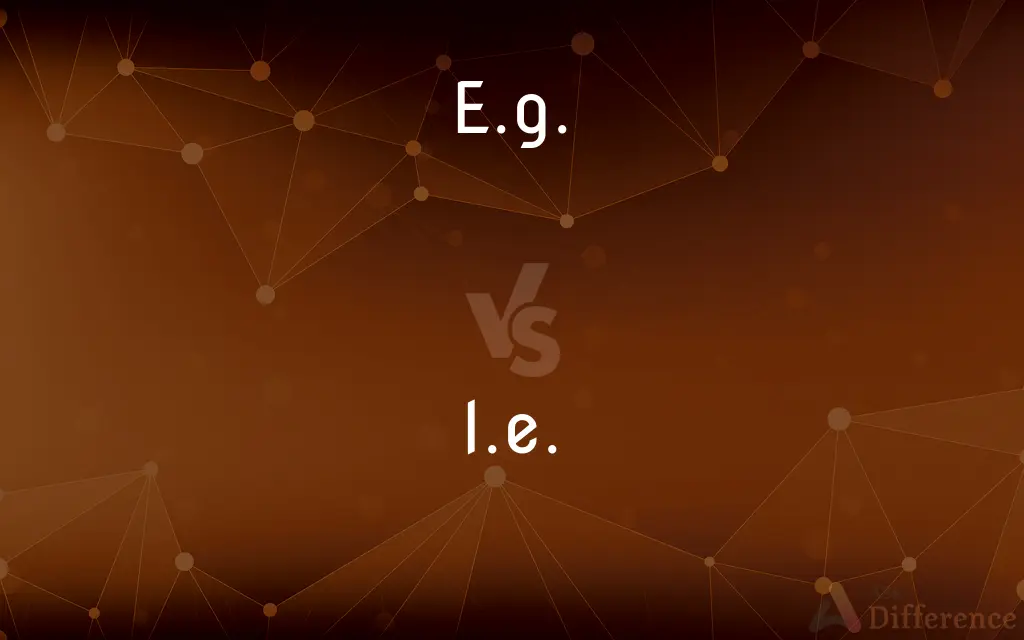E.g. vs. I.e. — What's the Difference?
By Tayyaba Rehman & Urooj Arif — Published on February 8, 2024
"E.g." means "for example," and "i.e." means "that is" or "in other words." E.g. introduces examples, while i.e. clarifies or specifies.

Difference Between E.g. and I.e.
Table of Contents
ADVERTISEMENT
Key Differences
E.g. is used to introduce examples relevant to the preceding statement. For instance, if discussing types of citrus, one might say, "I love citrus fruits, e.g., oranges and lemons." This indicates that oranges and lemons are examples of citrus fruits the speaker enjoys, without implying these are the only citrus fruits they like. Conversely, i.e. is used to clarify or specify the preceding statement more precisely. In the context of the same discussion about citrus fruits, one might say, "I only enjoy one type of citrus fruit, i.e., oranges." This specifies that oranges are the only citrus fruit the speaker enjoys, providing a precise clarification.
In writing, e.g. introduces examples that illustrate or expand upon the subject being discussed. It signals to the reader that what follows are specific instances that fall under the broader category mentioned before. For example, when listing favorite activities, one might write, "I enjoy outdoor activities, e.g., hiking and swimming." This suggests hiking and swimming are among the outdoor activities enjoyed, but not an exhaustive list. On the other hand, i.e. is used to provide a precise definition or clarification, narrowing down the scope of the subject. For example, "I have one hobby I truly love, i.e., painting." This sentence clarifies that painting is the specific hobby being referred to.
E.g. allows for the inclusion of multiple examples without the need to list every possible instance. It introduces a non-exhaustive list that helps in understanding the breadth of a topic. For instance, in discussing favorite foods, one might say, "I like many types of desserts, e.g., ice cream and cake." This indicates a preference for desserts, with ice cream and cake being examples, but not limiting the speaker's preference only to these. In contrast, i.e. focuses on providing a precise explanation or specifying a particular instance, limiting the interpretation to what is explicitly stated. For example, "My favorite season is the warmest part of the year, i.e., summer." This specifies that summer, being the warmest season, is the speaker's favorite.
E.g. serves to broaden the reader's understanding by presenting examples that are representative of a larger group. When discussing preferences or categories, e.g. can be used to suggest variety within a category without needing to enumerate every option. For example, "I'm interested in playing musical instruments, e.g., piano and guitar." This implies that the speaker is interested in these instruments among others in the category of musical instruments. Conversely, i.e. is employed to narrow down the focus to a specific detail or fact, eliminating ambiguity about the subject. For instance, "My ultimate career goal is in the field of medicine, i.e., to become a surgeon." This clarifies that becoming a surgeon is the specific career goal within the broader field of medicine.
E.g. and i.e. play distinct roles in clarifying and exemplifying information within a text. E.g. is particularly useful for providing examples that shed light on a topic by showcasing its diversity or range. It introduces instances like "In various cultures, traditional dances, e.g., the Salsa and the Tango, play a significant role," suggesting these dances are examples of the broader category of traditional dances. I.e., however, is crucial for pinpointing or defining information more narrowly, as in "I have a preferred genre of music, i.e., classical," which specifies that classical music is the particular genre in question.
ADVERTISEMENT
Comparison Chart
Purpose
Introduces examples
Clarifies or specifies
Implication
Suggests a non-exhaustive list
Indicates a precise explanation or equivalence
Usage Context
When listing examples to illustrate a broader category
When providing a clarification or a specific definition
Type of Information
Broad, illustrative
Narrow, definitive
Reader's Expectation
Anticipate examples that are part of a larger set
Understand a specific detail or rephrasing
Compare with Definitions
E.g.
Indicates a non-exhaustive list.
I enjoy reading, e.g., novels and comics.
I.e.
Clarifies or specifies.
My favorite season is autumn, i.e., the fall.
E.g.
Used to list instances.
I love fruits, e.g., apples and bananas.
I.e.
Provides specific details.
She's an expert in Greek mythology, i.e., ancient Greek stories.
E.g.
Precedes illustrative examples.
Many sports, e.g., soccer and basketball, are popular.
I.e.
Introduces a precise explanation.
He's a polyglot, i.e., fluent in multiple languages.
E.g.
Introduces examples.
Consider fast food, e.g., burgers and fries.
I.e.
Indicates "that is."
I practice a form of art, i.e., painting.
E.g.
Signifies "for example."
There are many exercises, e.g., jogging.
I.e.
Used for exact definitions.
Our goal is sustainability, i.e., long-term viability.
Common Curiosities
What does e.g. stand for?
E.g. stands for "exempli gratia," a Latin phrase meaning "for example."
What does i.e. stand for?
I.e. stands for "id est," a Latin phrase meaning "that is" or "in other words."
Can e.g. and i.e. be used interchangeably?
e.g. introduces examples, while i.e. provides clarification.
When should I use e.g. in a sentence?
Use e.g. when you want to provide examples to illustrate a broader point.
When should I use i.e. in a sentence?
Use i.e. when you need to clarify or specify a statement more precisely.
Should I always follow e.g. and i.e. with a comma?
Yes, in American English, it's common to follow both e.g. and i.e. with a comma.
Can I list multiple examples after e.g.?
Yes, you can list multiple examples after e.g., usually separated by commas.
Can I use "for example" or "that is" instead of e.g. or i.e.?
Yes, "for example" and "that is" are often used as clearer alternatives.
Are e.g. and i.e. used in formal writing?
Yes, but it's advisable to use their full English equivalents in very formal or academic texts.
Should I list all possible examples after e.g.?
No, just list a few examples; e.g. implies the list is not exhaustive.
Can i.e. be used to introduce a list?
No, i.e. is used to clarify or specify, not to introduce a list of examples.
Do I need to enclose e.g. or i.e. in parentheses?
They can be used with or without parentheses depending on the sentence structure.
Is it appropriate to use e.g. or i.e. at the beginning of a sentence?
It's uncommon; they're typically used mid-sentence to introduce examples or clarifications.
Is it necessary to italicize e.g. and i.e.?
It's not necessary, but they can be italicized to denote their Latin origin in formal writing.
How can I remember the difference between e.g. and i.e.?
Think of e.g. as "example given" and i.e. as "in essence" to remember their uses.
Share Your Discovery

Previous Comparison
Cool-Mist Humidifier vs. Warm-Mist Humidifier
Next Comparison
Novak Djokovic vs. Rafael NadalAuthor Spotlight
Written by
Tayyaba RehmanTayyaba Rehman is a distinguished writer, currently serving as a primary contributor to askdifference.com. As a researcher in semantics and etymology, Tayyaba's passion for the complexity of languages and their distinctions has found a perfect home on the platform. Tayyaba delves into the intricacies of language, distinguishing between commonly confused words and phrases, thereby providing clarity for readers worldwide.
Co-written by
Urooj ArifUrooj is a skilled content writer at Ask Difference, known for her exceptional ability to simplify complex topics into engaging and informative content. With a passion for research and a flair for clear, concise writing, she consistently delivers articles that resonate with our diverse audience.
















































